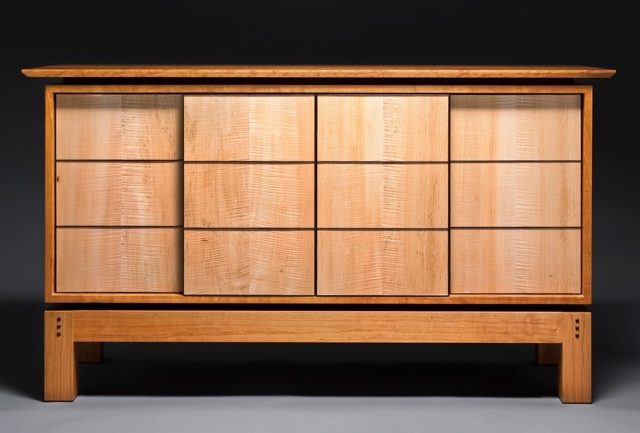
It might seem a bit strange that a guy who has lived most of his life in North Carolina would be so influenced by Japanese woodworking designs, but it just attests to the power of books. Right after Bayley Wharton got out of college, his sister got him the book “The Art of Japanese Joinery” (Kiyosi Seike, 1977), and it took hold of his imagination.
At the time, he was working for Broyhill Furniture Industries, but he was contemplating building his own furniture and trying to make a living at it. Now Bayley is the owner of Furniture x Design in Raleigh, North Carolina and spends his days building Japanese-influenced furniture for clients.
His flagship piece is what Bayley calls a Torii Table. It’s based on the Japanese Torii Gate and relies heavily on through mortise and tenon joints. The top is locked to the base with a metal fastener, but the rest of the table can be knocked down, much like a trestle table. He builds between 20 and 30 of these every year (more on that later).
While Bayley doesn’t get too involved with the really elaborate Japanese joinery, he incorporates a lot of traditional Japanese designs into his furniture. He built an entertainment center, for example, and the doors emulated a Shoji screen in an innovative way. Instead of paper, he used very light wood framed by darker wood on the cabinet doors. He also incorporates the Shoji screen into his lamp design.
He says what really draws him to Japanese design is the clean, simple lines in both form and construction. Within that framework Bayley tries to incorporate details that become focal points. “Often you can see there’s quite a bit of sophistication in the piece, even though the concept is simple,” he says.
Learning From the Big Boys
You might think that a furniture maker with Bayley’s flair and design sense would be completely frustrated working for Broyhill, but he says that wasn’t the case at all. It was, he argues, a great job to get right out of college and it taught him a lot. The most important thing he learned was mass production techniques and ways to maximize the efficiency of the work he would later do. That’s why he can make 20-30 Torii Tables a year – because he incorporated much that he learned at Broyhill into his woodworking business.
“Somewhere along the way I thought it would be unique to marry one-of-a kind craftsmanship with mass production techniques,” says Bayley. By learning the workflow at Broyhill – from rough cut lumber all the way to finished furniture ? he says he learned the philosophy of mass production.
Stop Designing and Drive
Bayley went back to graduate school for a degree in industrial design a few years back. It was there, he says, that he developed a lot of his design sense and really fined-tuned his ideas about design. Nevertheless, there’s as much art as there is science when it comes right down to designing a new piece of furniture.
“Sometimes when you’re trying your hardest to come up with a design, you really can’t,” says Bayley. “Then all of a sudden you’re off doing something ? driving across the state on a camping trip – and an idea hits you. Boy, it’s so clear and all the details come through all at once.” So if you’re driving around North Carolina and the guy in front of you seems a bit “distracted,” it could be Bayley designing furniture.
– Bob Filipczak







